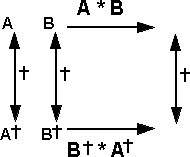Prerequisites
To check the conventions and notation look at the following page first:
Reverse
The reverse function of a multivector reverses the order of its factors, including the order of the base values within a component. The reverse function is denoted by †, so the reversal of A is denoted by A†.
so for 3D vectors, if A = B† then:
a.e = b.e321 = -b.e123
a.e1 = b.e32 = -b.e23
a.e2 = b.e13 = -b.e31
a.e3 = b.e21 = -b.e12
a.e12 = b.e3
a.e31 = b.e2
a.e23 = b.e1
a.e123 = b.e
The reversal function is important for a number of reasons, one reason is that it can map a multiplication into another multiplication with the order of the multiplicands reversed:
(A * B)† = B†* A†
We can think of this as a morphism where † maps to an equivalent expression with order of multiplication reversed.

Another application for the reversal function is to specify a transformation from one vector field to another:
pout = A pin A†
In other words, if pin is a pure vector (i.e. real, bivector and tri-vector parts are all zero) then pout will also be a pure vector. I would appreciate any proof of this.If you have a proof, that I could add to this page, please let me know, In the 3D case I guess I could try the brute force approach of multiplying out the terms for a general expression A and p.
I think this may also apply to:
pout = A pin A -1
but not every multivector is invertible, one condition that should ensure that a multivector is invertible is:
A A† = scalar
If we apply this restriction to a multivector based on 3D vectors then we get the quaternion algebra as described here.
This reverses the order of the indexes, for general information about n-dimentional reverse see this page.
Ar |
Ar† | A A† |
| 1 | 1 | 1 |
| e1 | e1 | 1 |
| e2 | e2 | 1 |
| e3 | e3 | 1 |
| e12 | e21 = -e12 | 1 |
| e31 | e13 = -e31 | 1 |
| e23 | e32 = -e23 | 1 |
| e123 | e321= -e123 | 1 |
Dual
This multiplies by e123 , for general information about n-dimentional dual see this page.
Ar |
Ar* = e123 Ar |
| 1 | e123 |
| e1 | e123e1= -e32 = e23 |
| e2 | e123e2= -e13 = e31 |
| e3 | e123e3= e12 |
| e12 | e123e12= -e3 |
| e31 | e123e31= -e2 |
| e23 | e123e23= -e1 |
| e123 | e123e123= -1 |
Conjugate
The conjugate of Ar is denoted Ar~ where: Ar~*Ar = I = psudoscalar, for general information about n-dimentional conjugate see this page.
If Ar represents a transformation then Ar~ reverses the transformation
Ar |
Ar~=(Ar†)* | Ar~*Ar |
| 1 | (1)* = e123 | e123 |
| e1 | (e1)* = e23 | e123 |
| e2 | (e2)* = e31 | e123 |
| e3 | (e3)* = e12 | e123 |
| e12 | (-e12)* = e3 | e123 |
| e31 | (-e31)* = e2 | e123 |
| e23 | (-e23)* = e1 | e123 |
| e123 | (-e123)* = 1 | e123 |
The last column confirms that Ar~*Ar = I = psudoscalar.
Norm
under construction
Inverse
Can we use the same trick that we used with complex numbers, that is multiply top and bottom of equation by the conjugate, which will convert the denominator into a scalar making the division possible.
Terminology:
| input | result (1/input) | |
| scalar | a.e | e |
| vector | a.e1 , a.e2 , a.e3 | e1 , e2 , e3 |
| bivector | a.e12 , a.e31 , a.e23 | e12 , e31 , e23 |
| trivector | a.e123 | e123 |
Since I'm not yet sure how to calculate the inverse of a multivector, I'll first try an easier problem, how to calculate the inverse of parts of a multivector (scalar, vector, bivector and trivector).
inverse of scalar
e-1 = 1/a.e
inverse of vector
(e1 + e2 + e3 )-1
use conjugate (-e1 - e2 - e3 )
so multiplying a vector by its conjugate gives:
(e1 + e2 + e3 ) (-e1 -e2 -e3 ) = -e12 -e22 -e32
so (e1 + e2 + e3 )-1 = (-e1 - e2 - e3 )/(-e12 -e22 -e32)
e1 = a.e1/(a.e12 +a.e22 +a.e32)
e2 = a.e2/(a.e12 +a.e22 +a.e32)
e3 = a.e3/(a.e12 +a.e22 +a.e32)
inverse of bivector
(e12 + e31 + e23)-1
use conjugate (-e12 - e31 - e23)
so multiplying a bivector by its conjugate gives:
(e12 + e31 + e23) (-e12 - e31 - e23) = e122 + e312 + e232
so (e12 + e31 + e23)-1 = (-e12 - e31 - e23)/(e122 + e312 + e232)
e12 = - a.e12/(a.e12 +a.e22 +a.e32)
e31 = - a.e31/(a.e12 +a.e22 +a.e32)
e23 = - a.e23/(a.e12 +a.e22 +a.e32)
inverse of trivector
e123-1 = a.e123 / (a.e123 * a.e123) = -1/a.e123
inverse of multivector
If it follows the pattern then it would be:
(e1 + e2 + e3 + e12 + e31 + e23 + e123)-1 = (e -e1 -e2 -e3 - e12 - e31 - e23 + a.e123)/(e2 - ex2 - ey2 - ez2 + e122 + e312 + e232 - e1232)
but is it? this would make the conjugate e -e1 -e2 -e3 - e12 - e31 - e23 + a.e123
so if we multiply a multivector by this possible conjugate we get:
(a.e1 + a.e2 + a.e3 + a.e12 + a.e31 + a.e23 + a.e123)(a.e -a.e1 -a.e2 -a.e3 - a.e12 - a.e31 - a.e23 + a.e123)
which gives:
e = a.e2 - a.e12 - a.e22 - a.e32 + a.e122 + a.e312 + a.e232 - a.e1232
e123 = 2*a.e * a.e123 - 2*a.e1 *a.e23 -2*a.e2*a.e31 - 2*a.e3*a.e12
so due to this extra e123 term this will only work if:
a.e * a.e123 = a.e1 *a.e23 + a.e2*a.e31 + a.e3*a.e12
which would make the extra term zero.
Although not necessary to calculate the inverse, the calculation would be a lot simpler if:
1 = a.e2 - a.e12 - a.e22 - a.e32 + a.e122 + a.e312 + a.e232 - a.e1232
so if,
a.e * a.e123 = a.e1 *a.e23 + a.e2*a.e31 + a.e3*a.e12
and
1 = a.e2 - a.e12 - a.e22 - a.e32 + a.e122 + a.e312 + a.e232 - a.e1232
then,
(e1 + e2 + e3 + e12 + e31 + e23 + e123)-1 = e -e1 -e2 -e3 - e12 - e31 - e23 + a.e123
